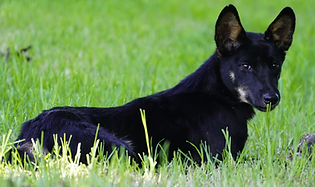
Back To PROJECTS
The Bunya Mountains Dingo

Dingoes, as apex predators, assist in maintaining balance within the Bunya Mountains eco-system.
You too can help keep the unique Bunya Mountains pristine by following the “Be Dingo Safe” advice.
Dingoes and humans can co-exist.
OBSERVE. RESPECT.
ENJOY. PROTECT.




WHAT IS A DINGO?
HISTORY: Dingoes arrived in Australia some 8,000 years ago. Across the Australian mainland, they vary in colour to suit their environment.
On the Bunyas, they are mainly black and tan to blend with the rainforest.
CHARACTERISTICS: Dingoes have large pointed ears, long muzzles and thick bushy tails. They have an acute sense of smell and hearing and are inquisitive.
INDIGENOUS CONNECTIONS: The word ‘dingo’ (din-gu) is adapted from the Dharug language (spoken around the Port Jackson region). All Indigenous language groups have different words for Dingoes. Dingoes are seen as a significant native animal.
HOW DINGOES COMMUNICATE
Dingoes communicate using
-
sound e.g. howling, snarling, yelping, singing.
-
body language:
-
Tail - raised and curled, limp, tucked tightly between back legs all send different messages
-
Ears - twitching (listening), laid back (fear or submission)
-
-
Posture - lying down, rolling over together
When dingoes are together, they chase, lunge, bite and wrestle. This is how they develop skills and learn about family hierarchy.
DINGO FAMILY LIFE
FAMILY GROUP STRUCTURE: Bunya Mts Dingoes live in family groups comprising:
-
the alpha male and female
-
dingo pups
-
juveniles from the previous season
-
additional individuals (generally females to assist with pups)
THE SEASONAL PATTERN OF DINGO FAMILY LIFE
Autumn – Howling Season.
Dingoes often heard but rarely seen.
This season, dingoes:
-
Mate
-
Consolidate family-group membership
-
Prepare the den for pups
Winter – Birthing Season
Dingoes rarely seen
This season:
-
Females birth pups
-
Other family members care for mother & pups
-
All stay close to the den
Spring - Training Season
Dingo family-groups visible together
This season:
-
Parents teach new pups the features and boundaries of their home range
-
Pups gain their skills and coordination
Summer – Independence Season
Separate individuals/juveniles observed
This season:
-
Pups/juveniles explore independently
-
The juveniles exhibit curiosity, often sitting and watching
-
The juveniles may not recognise imminent danger (e.g. not moving out of the way of cars)
BE DINGO SAFE
In nature, dingoes survive independently from humans. Any kind of human interaction is unnecessary and inadvisable.
Be aware and ensure you:
-
Observe and enjoy dingoes from a distance
-
Never feed or leave food around
-
Dispose of rubbish in bins provided
-
Keep BBQs, picnic areas and tables clean
IF YOU ENCOUNTER A DINGO:
-
Stand still, DO NOT run
-
Supervise children and keep them close
-
Cross arms - never ‘wave’ or ‘shoo’
-
Stay quiet
Never encourage or interact with a dingo.
REMEMBER: STAY CALM. OBSERVE. RESPECT.
WHAT DO DINGOES EAT?
Dingoes are omnivores. Their diet includes a variety of insects, reptiles and mammals.
However, they are opportunistic feeders; therefore, food or scraps should not be left around. When humans are seen as food-providers, serious unintended consequences occur. Much human food is harmful to the dingo digestive system. It also disrupts pup-training and acquisition of survival skills.
Bunya Mts Dingoes’ diet now also includes feral animals e.g. piglets, rabbits, cats and rats, thereby assisting to protect native flora and fauna.
WANT MORE INFORMATION:
Dingo Advisory Council. https://dingoadvisorycouncil.org
Send sightings/photographs to the dingo email: bunyadingolog@gmail.com
Information prepared by the Education sub-group of the interagency Bunya Mountains Dingo Stakeholders Group that includes representatives from interested bodies.
Thank you, photographers for permission to use these photos. Production of the brochure funded by a South Burnett Regional Council Community Grant.

